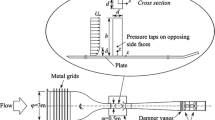Abstract
A new mechanism of the formation of spatially periodic structures on the nose surfaces of cylindrically blunted bodies in a hypersonic transverse flow is investigated. According to this mechanism, a curved shock wave produces a vortex flow, while the vortex, which is conserved in the presence of weak dissipation, acts on the shock and maintains its curved shape. The realizability of this vortex formation mechanism is verified by direct numerical simulation using the FLUENT software package. It is confirmed that in the case of uniform hypersonic freestream both plane and three-dimensional modes of the steady flow past the cylinder nose can exist. The three-dimensional mode is characterized by periodic-in-span vortex structures and considerable heat flux peaks on the nose surface. The calculated results are compared with the experimental data.
Similar content being viewed by others
References
N.A.V. Piercy and E.G. Richardson, “The Variation of Velocity Amplitude Close to the Surface of a Cylinder Moving through a Viscous Fluid,” Phil. Mag. Ser. 7 6(39), 970 (1928).
N.G. Lapina and V.A. Bashkin, “Experimental Investigation of the Flow Pattern and the Heat Transfer in the Vicinity of the Attachment Line of a Circular Cylinder in a Transverse Supersonic Flow with the Mach Numbers 3, 5, and 6,” Tr. TsAGI No. 2203, 44 (1983).
G. Hörtler and V. Tollmien (eds.), 50 Jahre Grenzschichtforschung. Eine Festschrift in Originalbeiträgen, Viewieg, Braunschweig (1958).
M.E. Goldstein, S.J. Leib, and S.J. Cowley, “Distortion of a Flat Plate Boundary Layer by Free-Stream Vorticity Normal to the Plate,” J. Fluid Mech. 237, 231 (1992).
M.V. Ustinov, “Receptivity of the Blunt-Leading-Edge Plate Boundary Layer to Unsteady Vortex Perturbations,” Fluid Dynamics 37(4), 556 (2002).
S. Bae, S.K. Lele, and H.J. Sung, “Influence of Inflow Disturbances on Stagnation-Region Heat Transfer,” Trans. ASME. J. Heat Transfer 122, 258 (2000).
S.M. Drozdov, “Vortex Structure Generation on the Frontal Surface of a Cylinder Set Transversely in a Hypersonic Flow,” Fluid Dynamics 41(6), 857 (2006).
V.V. Bogolepov and I.I. Lipatov, “Effect of Compressibility on the Development of Taylor-Görtler Vortices at High Reynolds Numbers,” Fluid Dynamics 32(1), 28 (1997).
F.R. Riddell (ed.), Hypersonic Flow Research, Acad. Press, New York (1962).
R.D. Quinn, “A Method for Calculating Transient Surface Temperatures and Surface Heating Rates for High-Speed Aircraft,” NASA TP-2000-209034 (2000).
Additional information
Original Russian Text © S.M. Drozdov, 2010, published in Izvestiya Rossiiskoi Akademii Nauk, Mekhanika Zhidkosti i Gaza, 2010, Vol. 45, No. 5, pp. 17–29.
Rights and permissions
About this article
Cite this article
Drozdov, S.M. Numerical modeling of three-dimensional vortex structures in hypersonic transverse flow past a cylinder. Fluid Dyn 45, 691–702 (2010). https://doi.org/10.1134/S0015462810050029
Received:
Published:
Issue Date:
DOI: https://doi.org/10.1134/S0015462810050029




